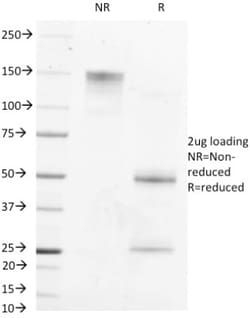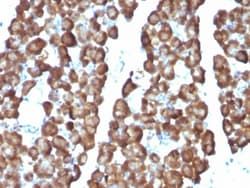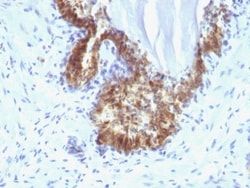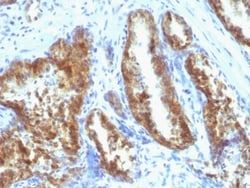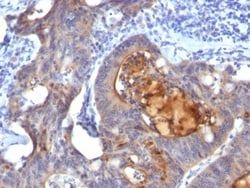Tyrosinase Antibody (OCA1/812), Novus Biologicals™
Mouse Monoclonal Antibody
Manufacturer: Fischer Scientific
The price for this product is unavailable. Please request a quote
Antigen
Tyrosinase
Concentration
0.2mg/mL
Applications
Flow Cytometry, Immunohistochemistry (Paraffin), Immunofluorescence
Conjugate
Unconjugated
Host Species
Mouse
Research Discipline
Lipid and Metabolism
Formulation
10mM PBS and 0.05% BSA with 0.05% Sodium Azide
Gene ID (Entrez)
7299
Immunogen
Recombinant human TYR protein
Primary or Secondary
Primary
Content And Storage
Store at 4C.
Molecular Weight of Antigen
75 kDa
Clone
OCA1/812
Dilution
Flow Cytometry 0.5 - 1 ug/million cells in 0.1 ml, Immunohistochemistry-Paraffin 0.5 - 1.0 ug/ml, Immunofluorescence 1 - 2 ug/ml
Classification
Monoclonal
Form
Purified
Regulatory Status
RUO
Target Species
Human
Gene Alias
CMM8, EC 1.14.18.1, LB24-AB, Monophenol monooxygenase, OCA1A, OCAIA, SHEP3, SK29-AB, Tumor rejection antigen AB, tyrosinase, tyrosinase (oculocutaneous albinism IA)
Gene Symbols
TYR
Isotype
IgG2a κ
Purification Method
Protein A or G purified
Test Specificity
Recognizes a cluster of proteins between 70-80kDa, identified as tyrosinase. Occasionally a minor band at 55kDa is also detected. This MAb shows no cross-reaction with MAGE-1 and tyrosinase-related protein 1, TRP-1/gp75. Tyrosinase is a copper-containing metalloglycoprotein that catalyzes several steps in the melanin pigment biosynthetic pathway; the hydroxylation of tyrosine to L-3,4-dihydroxy-phenylalanine (dopa), and the subsequent oxidation of dopa to dopaquinone. Mutations of the tyrosinase gene occur in various forms of albinism. Tyrosinase is one of the targets for cytotoxic T-cell recognition in melanoma patients. Staining of melanomas with this MAb shows tyrosinase in melanotic as well as amelanotic variants. This MAb is a useful marker for melanocytes and melanomas.
Description
- Ensure accurate, reproducible results in ELISA, Flow Cytometry, Immunohistochemistry (Paraffin), Immunofluorescence Tyrosinase Monoclonal specifically detects Tyrosinase in Human samples
- It is validated for Flow Cytometry, ELISA, Immunohistochemistry, Immunocytochemistry/Immunofluorescence, Immunohistochemistry-Paraffin, Immunofluorescence.

